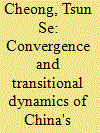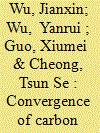| Srl | Item |
| 1 |
ID:
161811


|
|
|
|
|
| Summary/Abstract |
Many scholars have argued that the huge increase in regional inequality in China can be attributed greatly to the disparity in industrialization. This paper contributes to the literature by providing empirical evidence on the transitional dynamics of industrial output by employing a new framework of distribution dynamics analysis, namely, the mobility probability plot (MPP), and a county-level database made up of counties and county-level cities. The new framework can address several inadequacies of the traditional display tools used in the distribution dynamics literature. Stochastic kernel analyses are performed for the nation, the economic zones, and the provinces individually so as to provide an in-depth understanding of the evolution and convergence of industrial output. This study fills the gap in the literature and provides information on mobility of the county-level units, which can greatly aid the policy making process.
|
|
|
|
|
|
|
|
|
|
|
|
|
|
|
|
| 2 |
ID:
150890


|
|
|
|
|
| Summary/Abstract |
This paper investigates the spatial dynamics of per capita carbon dioxide (CO2) emissions in China. The analyses are conducted by employing a continuous dynamic distribution approach and panel data of 286 cities at the prefecture and above-prefecture level. The results show that per capita CO2 emissions tend to converge during the sample period of 2002–2011. However, multimodality is found in the ergodic distribution of the full sample. It is also found that there is more persistence in cities with low per capita CO2 emissions, and more mobility in cities with high per capita CO2 emissions. The analyses also show that the dynamics of per capita CO2 emissions are significantly different among various geographical, income and environmental policy groups. The conditional distribution analyses indicate that multimodality cannot be explained independently by any one of the two factors, namely geographical location or income level. The findings in this study may have important policy implications for CO2 abatement in China.
|
|
|
|
|
|
|
|
|
|
|
|
|
|
|
|
| 3 |
ID:
181619


|
|
|
|
|
| Summary/Abstract |
Increasing household energy consumption, mainly due to consumption upgrading, will create tough challenges for China if that country is to achieve peak carbon emissions in 2030 and carbon neutrality in 2060. However, this critical issue has not been explored comprehensively in the literature. Using China Family Panel Studies data and the distribution dynamics approach, this article is the first study to examine the relationship between quality of life (QOL) (proxied by consumption upgrading) and relative household energy consumption (RHEC). The results show that convergence clubs exist in all QOL groups for the RHEC, but they are more evident in the groups with lower middle and low QOL. This is encouraging because they suggest that an improvement in QOL does not necessarily lead to a higher level of energy consumption. The dataset was then divided into rural-urban and regional subgroups to further explore the impacts of these different characteristics on energy consumption. Significant disparities are found among the same QOL groups between urban and rural households and among different regions. The results derived from this study lead to pragmatic policy suggestions in areas including energy saving, emissions reduction, and particularly alleviation of inequality.
|
|
|
|
|
|
|
|
|
|
|
|
|
|
|
|